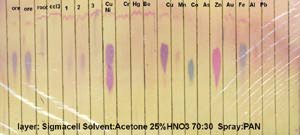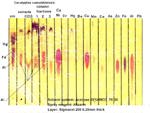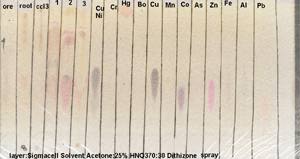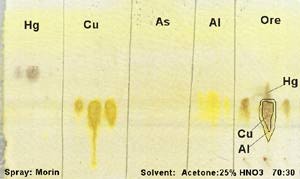--------------------------------------
Inexpensive and convenient methods for qualitative analysis of
heavy metals in Eucalyptus tissue and mine tailings are
described. Traditional published methods of thin layer
chromatography show promise for detecting cations of Mercury and
aluminum in plant tissue and mine tailings. Arsenic can also be
included if suitable detection methods are developed. It should
be possible to visualize the distribution of aluminum in the
plant tissue thin sections by means of Morin treatment and UV
microscopy.
Methods and materials
Silica gel (Sigma H) was coated on 10x20cm glass plates at a
thickness of 0.25mm using a Stahl-Desaga spreader. When acid
washed Silica gel is called for, the gel is soaked in conc HCl -
Acetone 1:5, followed by decanting, and three washes with double
distilled water. Sigmacell 200 was coated in a similar manner,
but was never acid washed. Lanes were scraped with a pointed
object and straightedge, followed by heating on a woodstove to
activate the gel layer.
Micropippette columns are constructed from a pasteur glass
pipette, a small paper disk and Silica gel 60. The paper disk is
punched to fit the inside of the pipette, and rammed down to the
taper with a dowel. Silica gel is filled to the halfway
point followed by several washes with solvent.
Eucalyptus roots and stems were broken into small pieces and
roasted at 290 deg C until vapors ceased to evolve. Vapor was
condensed onto the glass surface of a retort, or test tube and
later re-dissolved in chloroform or HNO3 with HCl (aqua regia).
In one experiment, hexane was used to pre-extract essential oils.
Charcoal from this digest is also treated with aqua regia.
The dissolved solids containing heavy metals, and other plant
products were concentrated by boiling and spotted onto a Silica
gel plate according to Stahl and eluted with one of several
solvent systems, which usually consisted of an organic
solvent plus pH buffer.
Control ions were made from a variety of available materials. No
attempt was made to obtain high purity standards. (As an example,
Lead was obtained by scraping a small amount of the shield
material from an old piece of Lead covered electrical wire and
dissolving it in aqua regia, Nickel was obtained by dissolving a
a coin in Nitric acid.) Most were dissolved in water or
HCl. These were spotted alongide the unknowns in separate lanes.
The standard procedure as published breaks down the ions into
groups by treatment with thioacetamide and centrifugation to
separate the Copper group followed by additional treatments with
thioacetamide at alkaline pH to divide out the (NH4)2S group.
The resulting solutions containing the ions of interest are
analyzed as follows:
Copper group is separated in n-butanol-1.5N HCl-acetonylAcetone
(100+20+0.5) migration sequence is Hg>Bi>Cd>Pb>Cu on MN Silica
Gel S-HR
(NH4)2S group is separated on MN Silica Gel S-HR with
Acetone-Conc HCl- acetonylAcetone (100+1+0.5)
migration sequence is Fe>Zn>Co>Mn>Cr>Ni>Al
In these experiments, the thioacetamide treatment was skipped in
the interest of finding a less cumbersome method that could be
used in the field.
Mixtures of heavy metals can be directly analyzed be pre-
treating the samples with Dithizone in chloroform. Sn Cu Hg Pb Cd
Zn are applied as the dithizonates on Silica Gel G and eluted
with Benzene. The Dithizone derivatives have colors that are
charactaristic and no spray reagents are required. Undreacted
Dithizone is present on the final plates, as well as oxidation
products that are located very close to the Hg spot.
Another method is much simpler, and was found to produce the
easiest separation. Acetone-25% HNO3 (70+30) and Cellulose are
used to separate Hg>Bi>Be>Cu>Ni>Ce according to the literature.
In these tests, additional ions were included and good
separations were achieved.
Several reagent sprays were formulated from published methods and
used to visualize the ions in question. After spraying, in most
cases Ammonia fumes are used to enhance or modify the reactions.
PAN result PAN- 1-(2-Pyridylazo)-2-napthol for Cd2+,
Co2+(light blue), Cu2+(violet), Mn2+(pink-violet),
Pb2+,Ni2+(violet), Zn2+(magenta), and UO2++ ions
used as 0.25% solution in ethanol followed by
ammonia vapor. Some reaction with Hg (pink) and Fe
(violet).
PAN- 1-(2-Pyridylazo)-2-napthol for Cd2+,
Co2+(light blue), Cu2+(violet), Mn2+(pink-violet),
Pb2+,Ni2+(violet), Zn2+(magenta), and UO2++ ions
used as 0.25% solution in ethanol followed by
ammonia vapor. Some reaction with Hg (pink) and Fe
(violet).
Dithiooxamide- for
Pb++,Co++,Cu++,Mn++,Ni++,Hg++,Bi++ ions used as
0.5% solution in ethanol followed by ammonia
vapor. Produces a rapid darkening for Copper.
Alizarin result Alizarin - for cations. Used in a .2% solution in
ethanol followed by ammonia vapor. One oxidation
state of Hg has a blue color.
Alizarin - for cations. Used in a .2% solution in
ethanol followed by ammonia vapor. One oxidation
state of Hg has a blue color.
Potassium Iodide (produces a red spot with Hg if
in high conc.) spray used as 2% solution followed
by ammonia vapor followed by Na2S spray (dark spot
for Hg).
8-Hydroxyquinoline for Ba++, Sr++ and Ca++ used as
a solution of 0.5g in 60ml ethanol and 40ml water
followed by ammonia. Observe under long wave UV.
Quercetin for cations of the Copper and ammonium
sulphide group used as 0.2% solution in ethanol
followed by ammonia vapor and UV light.
Diphenylcarbazide for Ag+, Pb++, Hg++, Cu++, Sn++,
Mn++,Zn++, and Ca++ was used in 2% soln in ethanol
followed by ammonia vapor. Additional heating to
80 degrees centigrade will produce a blue violet
color from Mercuric acetate adducts.
Dithizone direct method Dithizone produces colored derivatives and can be
sprayed directly.
Dithizone produces colored derivatives and can be
sprayed directly.
Results and discussion
When N-propanol-1.5N HCl-AcetonylAcetone or Acetone-Conc HCL-
AcetonylAcetone were used as solvent systems on Silica gel H or
Acetone- 25% HNO3 was used for elution on layers of Sigmacell 200
then sprayed with PAN, dithio-oxamide, Diphenylcarbazide,
Alizarin, Morin, Postassium iodide, Sodium Sulfide solution,
Dithizone, Quercetin, 8-Hydroxyquinoline, colored spots and bands
appeared that where characteristic in position and color for each
of the test ions. Careful examination of the plates at each stage
of the process yielded useful diagnostic information.
Improvements in pre-separating the Eucalyptus extracts included
attempts at roasting using crucible, test tubes, and glass
retorts. The oily residues(note 1) from the roasting process
could be shown to contain some Mercury, but the greatest amounts
were found in the charcoal residue. If the roasting temperatures
were kept below 300 degrees centigrade, the Mercury didn't
vaporize, and appeared on the tlc plates. If the temperatures
exceeded 300 degrees, only aluminum remained in the ash, along
with other ions that were not identified.
Arsenic could not be visualized with any of the spray reagents
used, but in some cases, masking of background color could be
used to identify the location of Arsenic on the plate. It was not
possible to confirm the presence of Arsenic in any of the roasts
using this method.
Morin result Aluminum was best visualized using Morin as an indicator as it
produced intense fluorescence under UV. It was possible to
identify Aluminum in the charcoal residue without question. Some
reagents produced distinctive colors, or noreaction, allowing for
a process of elimination. Aluminum suffers from blocking by
Copper on several of the solvent systems, but the intensity of
the fluorescence using Morin is sufficient to reveal a fringe of
aluminum just surrounding the dark zone produced by the Copper,
in an eclipse like manner.
Aluminum was best visualized using Morin as an indicator as it
produced intense fluorescence under UV. It was possible to
identify Aluminum in the charcoal residue without question. Some
reagents produced distinctive colors, or noreaction, allowing for
a process of elimination. Aluminum suffers from blocking by
Copper on several of the solvent systems, but the intensity of
the fluorescence using Morin is sufficient to reveal a fringe of
aluminum just surrounding the dark zone produced by the Copper,
in an eclipse like manner.
Copper produced distinct color reactions and was easily
identified. It could be detected with every system used, and from
every sample tested. Reaction time with Diphenylcarbazide was
rapid and was diagnostic. Copper could be visualized just above
and partly overlapping the spot for Iron.
Most of the reagents produced a colored spot with Mercury, Na2S
produced a dark spot, that did not seem to be affected by the
presence of plant oils. The amount of Mercury in these samples
is much less than that of Aluminum.
When heavily loaded, the extracted Mercury can be found leading
all other ions in the sample lane, but merged together in a
cluster in some solvent systems. By using each spray reagent (on
separate plates) one can identify each component of the cluster
by position and color. In this manner it was possible to rule
out Ni, Co, Bo, but Manganese and Iron
are candidates for several unidentifiable spots that often
overlap Mercury in these assays. When KI and Na2S are used,
however, only one dark area appears where the Mercury should be,
its shape modified by the overlap of the now unseen substances.
In the straight ore extracts, there are a number of substances
overlapping the Mercury area, color indicating that the
predominant ion being Iron. In these plates, the Iron completely
blocks the signal from the Mercury.
Another system involves the pre-reaction of the sample with
Dithizone in Chloroform. The colored reaction products are then
spotted on Silica gel G and eluted with benzene. The Dithizone
reaction products are colored, and no sprays are needed to
visualize the spots. In this case, it was possible to detect
Mercury in the root samples where there was contamination with
Copper or other materials due to the difference in separation
characteristice of the Dithizone product. The Mercury complex
appeared close to the solvent front as a distinct orange spot.
Pre-concentration of samples is necessary to bring out a dark
spot on the plate. One method is so use a simple piece of
cellulose paper and solvent to pre-chromatograph a large amount
of extract. The solvent front area of the paper is cut off and
re-eluted at 90 degrees to the first run, bringing all the
Mercury to the end of the paper strip. This can then be spotted
with a bit of reagent, and the color observed, or washed out and
concentrated for spotting on a regular tlc plate. Also, columns
of Silica gel made up from pipettes could be used to pre-elute
the extract. These methods are still in development, and show
great promise.
Summary of analysis of root and ore:
Chromium, Boron, Nickel and Zinc, can be ruled out in ore and
root samples.
Possibly Manganese (pink) and quite likely Iron (dark blue) can
be detected in ore using PAN, or Alizarin as indicator, and may
be present in small amounts in root as well.
Aluminum is detectable in ore and root when plates are sprayed
with Morin solution and observed under UV, and by color reactions
with PAN and Alizarin, and by lack of color reaction with other
reagents.
Mercury is detectable in ore and root using KI, Na2S, Alizarin,
Dithizone directly, or pre-derivitivized, Dithio-oxamide, or
Diphenylcarbazide. Hg content of root is low and difficult to
detect, except for Alizarin reaction which seems quite
sensitive for only one of the Hg oxidation states.
One or more of these methods can be readily adapted into a
stable system for routine screening of specimens, at low cost,
and with readily available materials.
----------------------------------------------------------
note 1
Methods of preparation of organic samples must take into
consideration different degrees of binding between plant
essential oils and heavy metals. These adducts need to be
explored in greater detail.
 PAN- 1-(2-Pyridylazo)-2-napthol for Cd2+,
Co2+(light blue), Cu2+(violet), Mn2+(pink-violet),
Pb2+,Ni2+(violet), Zn2+(magenta), and UO2++ ions
used as 0.25% solution in ethanol followed by
ammonia vapor. Some reaction with Hg (pink) and Fe
(violet).
PAN- 1-(2-Pyridylazo)-2-napthol for Cd2+,
Co2+(light blue), Cu2+(violet), Mn2+(pink-violet),
Pb2+,Ni2+(violet), Zn2+(magenta), and UO2++ ions
used as 0.25% solution in ethanol followed by
ammonia vapor. Some reaction with Hg (pink) and Fe
(violet).
 Alizarin - for cations. Used in a .2% solution in
ethanol followed by ammonia vapor. One oxidation
state of Hg has a blue color.
Alizarin - for cations. Used in a .2% solution in
ethanol followed by ammonia vapor. One oxidation
state of Hg has a blue color.
 Dithizone produces colored derivatives and can be
sprayed directly.
Dithizone produces colored derivatives and can be
sprayed directly.
